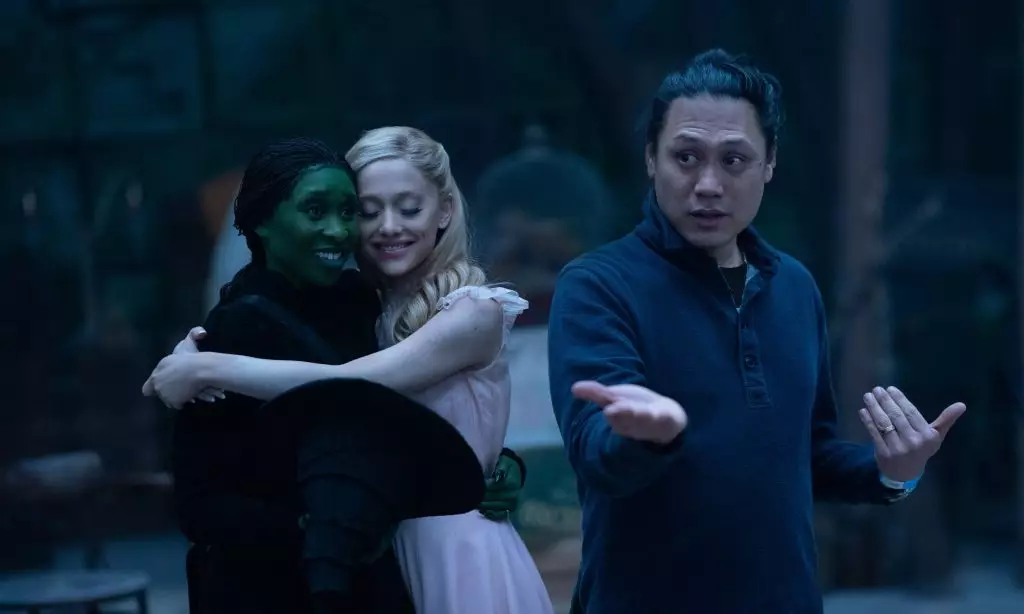Jon M. Chu, the acclaimed director known for his work on “Crazy Rich Asians,” has recently shared insights into his artistic decisions for the long-awaited screen adaptation of the musical “Wicked.” Following some criticism regarding the film’s visual style, particularly its color grading which deviates from the vibrant hues of the 1939 classic, “The Wizard of Oz,” Chu took the opportunity to clarify his vision for this familiar yet redefined world.
The transformative essence of Oz has long been associated with its brighter-than-life colors, but Chu’s approach deliberately steps away from that tradition. In an interview with The Globe and Mail, he confronted the reception of his film’s desaturated palette, asserting that colors permeate the film realistically, aiming to create a visceral experience that mirrors the authenticity of the characters’ journeys. By grounding the depiction of Oz in an organic aesthetic, Chu emphasizes the importance of real relationships over fantastical visuals.
Creating an Authentic World
Chu’s intention behind the film’s aesthetic choices was clear: he sought to immerse viewers in a tangible world rather than present a mere illusion. “If it was a fake place, if it was a dream in someone’s mind, then the real relationships and the stakes that these two girls are going through wouldn’t feel real,” he explained. To achieve this, he aimed to capture the richness of the environment—the dirt, the wear and tear, and the natural light permeating the vast landscapes of Oz. This signifies a departure from the slick, polished visuals typical of modern productions, opting instead for a look that suggests authenticity and relatability.
As the discourse around the film’s color palette unfolded online, fans voiced differing opinions, with some criticizing the “drab” appearance while others defended its unique style. The stark contrasts of the film have been compared unfavorably to the classic technicolor era; however, Chu points to the inherent limitations of replicating such a visual style due to outdated technology and prohibitive costs. The filmmaker’s focus on grounded visual storytelling instead invites the audience to directly connect with the physical and emotional landscape navigated by the protagonists, Elphaba and Glinda.
The visual presentation has led to robust discussions about how aesthetic choices shape narratives within adaptations. Chu has emphasized that the intertwining of the protagonists’ relationships with their environment is essential to the plot, which encompasses deep emotional themes that resonate with audiences. As the film encapsulates the evolution of Elphaba and Glinda’s friendship, juxtaposed with their growing challenges, Chu’s stylistic decisions enhance the depth of their journeys.
Despite the mixed reactions regarding its aesthetic, “Wicked” has found significant success at the box office. This adaptation has broken numerous records, including having the largest global and domestic opening for a film inspired by a Broadway production. With its $205 million opening weekend, the film has marked a significant resurgence for musicals in film, positioned alongside heavyweights like Ridley Scott’s “Gladiator II.” Notably, Chu’s vision and strategic direction have drawn attention not just for its visual elements but for its ability to connect with audiences on a broader scale, igniting excitement for a genre that many feared was faltering.
“Wicked” operates on multiple levels beyond mere entertainment; it is a cultural phenomenon that challenges traditional narratives surrounding characters within “The Wizard of Oz.” It allows audiences to explore themes of identity, friendship, and the complexity of moral choices. Chu’s delicate balance of visual authenticity and layered storytelling not only revitalizes a beloved tale but also reexamines that story’s morality through a contemporary lens.
As “Wicked” continues to captivate audiences globally, the dialogue surrounding its aesthetic choices demonstrates an essential aspect of filmmaking: the importance of subjective experience in art. By confronting both praise and criticism, Chu’s vision for the film encapsulates the broader complexities of narrative adaptation, inviting fans old and new to experience Oz in a way that feels both familiar and distinctly fresh. In doing so, he reaffirms the timeless relevance of this narrative, emphasizing that real magic may be found not just in bright colors, but in the depth of human connection and the power of storytelling.

Leave a Reply